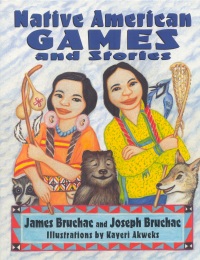| ________________
CM . . . . Volume XVIII Number 28 . . . . March 23, 2012
excerpt:
Native American Games and Stories, written by Joseph Bruchac, a well-known Native American writer and storyteller, and his son, James Bruchac, also a writer and storyteller, provides a look at some of the games played by different Native American peoples, along with related stories and legends. This combination of authors is excellent and has resulted in an extremely well-written and well put together book.
Each specific game is presented with well-written instructions. An overview of the game and how it is played are then followed by the suggested rules, how to score the game and any equipment that is needed. The sections are clearly indicated, which makes it easy to quickly look up information on that game. The only problem in the presentation of the games is a lack of any suggested ages for the players. Although some games, like Stickball, include a note about a modified version for younger players, there are no guidelines for what ages that could be playing the games. As a result, anyone wanting to play one of the games should read the instructions very carefully to ensure that the game is age-appropriate. Native American Games and Stories is a great resource about some of the games played by different Native American tribes, as well as the role that these games have played in Native American culture. This book would be good for many different types of readers, including as a resource for teachers. Recommended. Daphne Hamilton-Nagorsen is a graduate of the School of Library, Archival and Information Studies at the University of British Columbia, Vancouver, BC.
To comment
on this title or this review, send mail to cm@umanitoba.ca.
Copyright © the Manitoba Library Association. Reproduction for personal
use is permitted only if this copyright notice is maintained. Any
other reproduction is prohibited without permission.
NEXT REVIEW |
TABLE OF CONTENTS FOR THIS ISSUE
- March 23, 2012.
AUTHORS |
TITLES |
MEDIA REVIEWS |
PROFILES |
BACK ISSUES |
SEARCH |
CMARCHIVE |
HOME |

 The book is broken into sections based on the type of games (ball games, games of chance, etc.). Each section gives a brief overview of that type of game, followed by one or more related stories. The final part of each section presents the instructions for two to five games. The structure of the book works well as it not only introduces the different types of games, but it also allows the reader to see how the games are presented in Native American stories and culture.
The book is broken into sections based on the type of games (ball games, games of chance, etc.). Each section gives a brief overview of that type of game, followed by one or more related stories. The final part of each section presents the instructions for two to five games. The structure of the book works well as it not only introduces the different types of games, but it also allows the reader to see how the games are presented in Native American stories and culture.